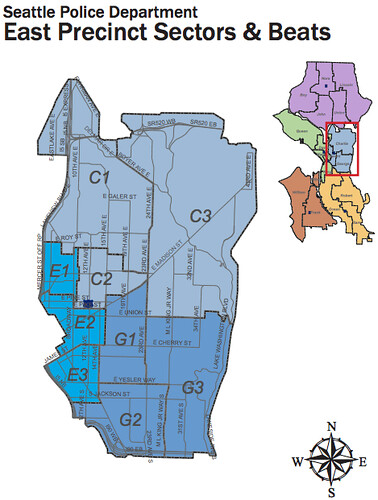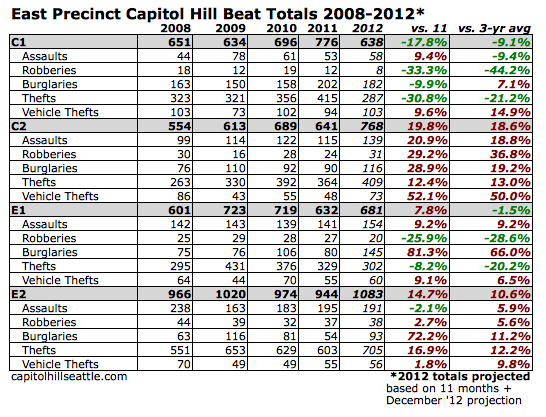 Rainbow crosswalks on Capitol Hill may only be the most visible project newly formed LGBTQ+allies community group Social Outreach Seattle is undertaking. The community group will also meet with East Precinct officials this week to discuss concerns about what the organization says is a troubling rise in violent crime on Capitol Hill. Our just-compiled numbers for neighborhood crime in 2012 will only add fuel to the effort — burglaries and assaults were on pace for terrible annual totals even as reports of the higher-profile robberies looked likely to fall for the second consecutive year across the Hill’s SPD beats.
Rainbow crosswalks on Capitol Hill may only be the most visible project newly formed LGBTQ+allies community group Social Outreach Seattle is undertaking. The community group will also meet with East Precinct officials this week to discuss concerns about what the organization says is a troubling rise in violent crime on Capitol Hill. Our just-compiled numbers for neighborhood crime in 2012 will only add fuel to the effort — burglaries and assaults were on pace for terrible annual totals even as reports of the higher-profile robberies looked likely to fall for the second consecutive year across the Hill’s SPD beats.
Based on 11 months of data from SPD and a projection for December’s totals, crime on the streets around Capitol Hill’s dense core above and below Broadway appears to have leapt significantly in the past year fueled by a rise in assaults and a remarkable leap in reported burglaries.
“While crime may not be getting worse, it does seem to be getting more violent and involve weapons — guns in particular,” spokesperson Daniel Hanks tells CHS. “That is what has prompted SOSea to say that violent crime is on the rise. And I don’t think that anyone can deny that the streets of Capitol Hill have gotten much more aggressive.”
The group and a newly formed Straight Allies for Equality (SAFE) group will meet with officials including East Precinct commander Capt. Ron Wilson later this week to brief the SPD brass on safety initiatives the groups are launching and “visibility events” being planned to show “criminals operating in the area that a change has occurred; residents are now watching and have been empowered to become actively engaged in keeping the neighborhood crime free.” There is more on the effort documented in this essay on the SOSea site.
Taken as a whole, the 2012 trends are only moderately alarming — overall, crime across the main categories tracked by SPD is on pace for something around a 6% year over year rise. We’re working with the first 11 months of SPD data for 2012 — for December, we went with the simplest possible projection and used the 2011 December totals. Science? No. But 2012’s trends are on pace for a troubling year with or without the final four weeks.
The granular breakdown of the trends across the precinct’s beats reveals some areas of improvement and much of the bad news from 2012.
SOSea might want to plan a few of its visibility events around burglary in the densely populated E1 beat that covers the area dominated by multifamily housing below Broadway. The 2012 totals are on pace for a whopping 80%+ jump for reported break-ins in the neighborhood. You can see First Hill’s E2 also is on pace for a burglary spike after a downtick in 2011.
Meanwhile, central beat C2 just needs help in general as it appears likely to turn in big jumps in each of the main categories. We’ll have to ask what was behind the change in burglaries and “theft” in C1. Whatever SPD did, it worked in the northern reaches of the Hill. SOSea might also want to focus on assaults as three of the four beats that cover most of Capitol Hill were on pace for increases.
“We’re still looking at areas that might need attention,” Wilson tells CHS about East Precinct’s efforts in the neighborhood. The Friday and Saturday “nightlife emphasis,” Wilson said, continues “at some cost to the precinct.”
Wilson said many precinct trends are economically driven. “It’s not surprising to find economic drivers around holidays when people need more money,” Wilson said of recent incidents. Hanks acknowledges that drugs are another likely factor in the increase.
One datapoint the SPD statistics do not reveal is the number of crimes involving firearms. We have no good way to quantify the incidence of robberies and assaults involving guns on the Hill on any basis. Two incidents not included in the above statistics are the homicides that occurred in 2012 on Capitol HIll and First Hill. Darek Darewski was shot to death on Harvard Ave last January while Gloria Leonidas was shot and killed during the Cafe Racer spree in the spring. In the wake of the Sandy Hook school shooting, the Seattle City Council has formed a committee to consider making a push for greater civic autonomy to control guns in the state. On Sunday, the Stand Up Against Gun Violence march and rally will start at Westlake.
Back on Capitol Hill, what impact on the 2013 trends will this week’s East Precinct meeting have? A community effort at the scale talked about by SOSea hasn’t been seen since the days of the Q-Patrol. SPD, meanwhile, has more money in the latest budget to hire officers but that’s a change that will take more time to play out.
SOSea’s Hanks says it’s time to give the issue more attention.
“I want to be clear about something and that is: Any attack, mugging, or worse should not be tolerated by members of the LGBTQ and Allied communities,” he writes. “Why are these criminals coming to the Hill to commit these crimes? I don’t think it is too far fetched to say it is because they think the gays would be an easy target. I’m not saying that these crimes, on the individual basis, motivated by homophobia. Conversely, I’m not willing to say that they are all circumstantial to the fact that the economy is bad or that new condos have moved more straight people to the Hill. Who’s to know?”





6% overall per year rise–and by what percent has the population grown year over year?
That is a great question, because developers and our city council would like us to believe that exponentially increasing density comes with no cost to quality of life.
I don’t think we should be complacent to simply accept a 6% rise in crime in our neighborhood. We should be working towards a negative percentage, I wonder how Capitol Hill’s crime rates compare to other neighborhoods in the city.
Little bells began going off after reading the article and one of the foregoing comments and I remembered a famous study of overcrowded living conditions conducted on rats. I did a bit of research and any of you who have followed the aPodment debate are going to love this because the study performed by Calhoun (yes, the same name as that of the developer of a lot of these aPodment complexes) demonstrated that the rats became vicious and aggressive in overcrowded living conditions (the term “behavioral sink” was developed following the publication of this study’s results in 1962). Interesting.
Actually, I’m suggesting that if population has also grown by 6%, then we have the same rate of crime as last year. The overall number is up in part because there are more residents, which is to be expected. (I don’t actually know the numbers, and I do want to see things in action to make crime #s go in reverse.)
Apodments are hardly an example of overcrowding. You might get out if Seattle and see some major cities throughout the world. This city is so pussy.
Just a few weeks ago jseattle and others pointed out that they thought I was being alarmist, because the last few years don’t seem to have noticeably different crime rates, but I’ve been feeling the rise in crime, so it’s nice (but sad) to see the numbers support me. Now we need to do something about it.
…which of course explains why Tokyo is one of the most dangerous cities in the world.
Good thing we’re not rats, eh?
Also I have this sneaking suspicion that the overcrowding of these rats was well beyond Capitol Hill’s density. The rats probably also didn’t have their own living spaces…
[…] Earlier this year, CHS on troubling crime trends around Capitol Hill: […]
[…] The latest CHS analysis of crime data for the East Precinct beats that cover Capitol Hill showed a jump in incidents across the Hill last […]